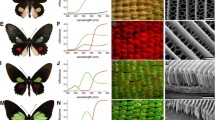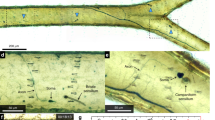Summary
Pieris butterflies use a novel behavioral posture for thermoregulation called reflectance basking, in which the wings are used as solar reflectors to reflect radiation to the body. As a means of exploring the thermoregulatory significance of wing melanization patterns, I examine the relation of basking posture and wing color pattern to body temperature. A mathematical model of the reflectance process predicts certain combinations of dorsal wing melanization pattern and basking posture that maximize body temperature. Laboratory experiments and field observations show that this model correctly predicts qualitative differences in the relation of body temperature to basking posture based on differences in the extent of dorsal melanization on the wing margins, both between species and between sexes within species of Pieris. This is the first demonstration in insects that coloration of the entire wing surface can affect thermoregulation. Model and experimental results suggest that, in certain wing regions, increased melanization can reduce body temperature in Pieris; this effect of melanization is exactly the opposite of that found in other Pierid butterflies that use their wings as solar absorbers. These results are discussed in terms of the evolution of wing melanization pattern and thermoregulatory behavior in butterflies.
Similar content being viewed by others
References
Bakken GS (1976) A heat transfer analysis of animals: unifying concepts and the application of metabolic chamber data to field ecology. J Theoret Biol 60:337–384
Bowden SR (1979) Subspecific variation in butterflies: adaptation and dissected polymorphism in Pieris. J Lepid Soc 33:77–111
Chew F (1975) Coevolution of Pierid butterflies and their Cruciferous foodplants. I. The relative quality of available resources. Oecologia (Berlin) 20:117–127
Courtney SP (1984) The evolution of egg clustering by butterflies and other insects. American Naturalist 123:276–281
Douglas MM, Grula JW (1978) Thermoregulatory adpatations allowing ecological range expansion by the Pierid butterfly, Nathalis iole. Evolution 32:776–783
Hayes JL (1981) The population ecology of a natural population of the pierid butterfly Colias alexandra. Oecologia 49:188–200
Heinrich B (1970) Thoracic temperature stabilization by blood circulation in a free-flying moth. Science 168:580–582
Kingsolver JG (1983a) Thermoregulation and flight in Colias butterflies: elevational patterns and mechanistic limitations. Ecology 64:534–545
Kingsolver JG (1983b) Ecological significance of flight activity in Colias butterflies: implications for reproductive strategy and population structure. Ecology 64:546–551
Kingsolver JG, (1985) Thermal ecology of Pieris butterflies: a new mechanism of behavioral thermoregulation. Oecologia (Berlin) 66:540–545
Kingsolver JG, Moffat RK (1982) Thermoregulation and the determinants of heat transfer in Colias butterflies. Oecologia (Berlin) 53:27–33
Kingsolver JG, Watt WB (1983) Thermoregulatory strategies in Colias butterflies: thermal stress and the limits to adaptation in temporally varying environments. American Naturalist 121:32–55
Kingsolver, JG, Watt WB (1984) Mechanistic constraints and optimality models: thermoregulatory strategies in Colias butterflies. Ecology 65:1835–1839
Rawlins JE, Lederhouse RC (1978) The influence of environmental factors on roosting in the black swallowtail, Papilio polyxenes asterius. J Lepid Soc 32:145–159
Shapiro AM (1974) Beak-mark frequency as an index of seasonal predation intensity on common butterflies. American Naturalist 108:229–232
Shapiro AM (1976) Seasonal polyphenism. Evol Biol 9:259–333
Tabashnik BE (1980) Population structure of Pierid butterflies. III. Pest population of Colias philodice eriphyle. Oecologia (Berlin) 47:175–183
Turner JRG (1977) Butterfly mimicry: the genetic evolution of an adaptation. Evol Biol 10:163–206
Wasserthal LT (1975) The role of butterfly wings in regulation of body temperature. J Insect Physiol 21:1921–1930
Watt WB (1968) Adaptive significance of pigment polymorphisms in Colias butterflies. I. Variation of melanin pigment in relation to thermoregulation. Evolution 22:437–458
Watt WB (1968) Adaptive significance of pigment polymorphisms in Colias butterflies. II. Thermoregulation and photoperiodically controlled melanin variation in Colias eurytheme. PNAS 63:767–774
Watt WB, Han D, Tabashnik BE (1979) Population structure of Pierid butterflies. II A ‘native’ population of Colias philodice eriphyle in Colorado. Oecologia (Berlin) 44:44–52
Author information
Authors and Affiliations
Rights and permissions
About this article
Cite this article
Kingsolver, J.G. Thermoregulatory significance of wing melanization in Pieris butterflies (Lepidoptera: Pieridae): physics, posture, and pattern. Oecologia 66, 546–553 (1985). https://doi.org/10.1007/BF00379348
Received:
Issue Date:
DOI: https://doi.org/10.1007/BF00379348




